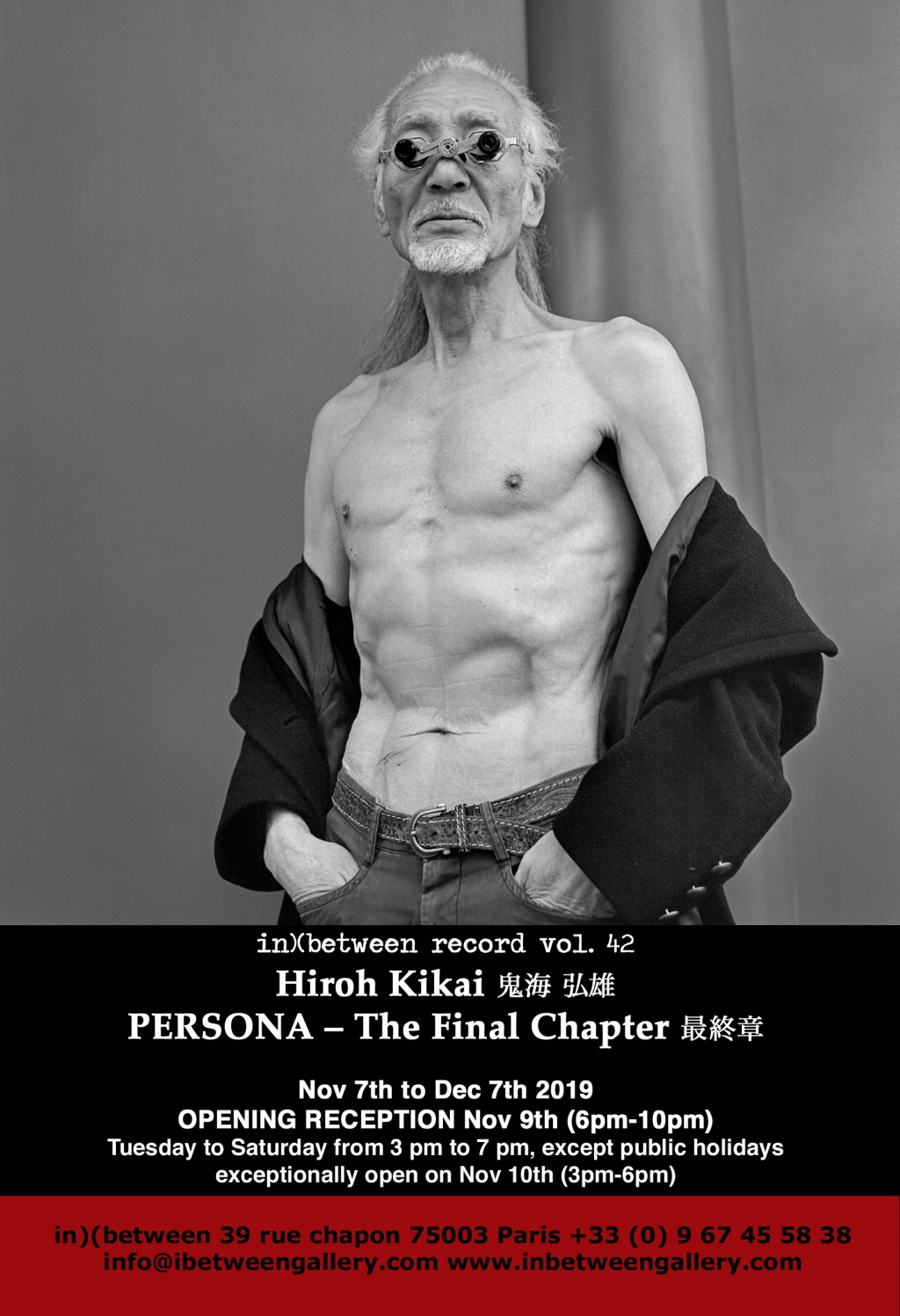
in)(between record vol. 42
Du 7 nov au 7 déc 2019
Vernissage le 9 novembre
Hiroh Kikai a décidé d’organiser sa dernière exposition en galerie de la série Asakusa Portraits - PERSONA à la galerie in)(between. Pour « PERSONA - Final Chapter », la deuxième exposition de l’artiste à in)(between, Luigi Clavareau a réalisé une sélection parmi les 113 œuvres monochromatiques récemment présentées au Musée de la photographie de la ville de Nara (Japon), du 7 septembre au 30 octobre 2019.
in)(between record vol. 42 inclut des portraits réalisés entre 2005 et 2018, ce qui correspond au chapitre final de sa série intitulée PERSONA, entamée en 1973. Hélas, en raison du cancer contre lequel il lutte actuellement, Hiroh Kikai ne sera pas à Paris pour sa dernière exposition PERSONA.
Hiroh Kikai est, depuis 25 ans, l’un des plus grands noms de la photographie japonaise contemporaine. Ses œuvres ont été exposées dans de nombreuses galeries et musées à travers le monde, notamment au Musée métropolitain de la photographie de Tokyo, à l’International Center of Photography de New York, à la nouvelle Galerie nationale de Berlin, et au Musée de la photographie de la ville de Nara. Elles ont été présentées en France pour la première fois à la galerie in)(between, en 2013.
Hiroh Kikai est né en 1945 à Daigo, un village qui fait maintenant partie de Sagae, préfecture de Yamagata. Étudiant en philosophie à l’université Hosei de Tokyo, il découvre par hasard les œuvres de Diane Arbus. Frappé par la qualité de son travail photographique, Hiroh Kikai décide, en 1969, d’acheter son premier appareil photo, un Hasselblad qu’il utilise toujours aujourd’hui. Ses œuvres les plus connues sont trois séries de photographies : les Asakusa Portraits Persona, qui présentent le sens de l’existence des personnes vivant dans le quartier d’Asakusa, près du temple bouddhiste Senso-ji de Tokyo, du milieu des années 1970 jusqu’à 2018 ; Labyrinthes, représentant des espaces déserts à Tokyo ; ainsi que des instantanés pris en Inde. Dans ses photographies, l’artiste tente de saisir l’essence fondamentale de l’existence humaine. En 1988, la Société photographique japonaise (PSJ) lui attribue le prix du « Nouveau-venu » pour son livre Ecce Homo: Portraits of Kings et l’exposition associée, qui lui valent également de remporter le troisième prix Ina Nobuo. En 1993, il reçoit le prix de la Société de photographie pour son livre India et, en 2004, le prix Ken Domon et le prix annuel de la Société photographique japonaise pour son livre Persona.
Avec son Hasselblad, Hiroh Kikai a sillonné pendant plus de 45 ans les rues d’Asakusa, un quartier populaire et animé de Tokyo. L’artiste est à la recherche de personnalités singulières, inhabituelles ou atypiques, des individus que Kikai « le philosophe » considère comme représentatifs de l’âme invisible d’Asakusa et, plus généralement, du Japon. Avec « PERSONA », Hiroh Kikai souhaite montrer l’identité profondément enfouie du Japon. Pendant les années qu’il passe à arpenter Asakusa, il sélectionne soigneusement ses PERSONA parmi les centaines de passants qu’il croise, capable de parcourir sans cesse les mêmes rues pendant près de vingt-quatre heures avant qu’une rencontre déterminante ne se produise. Les portraits qu’il a réalisés à Asakusa transcendent l’image culturelle, sociale et religieuse fabriquée du Japon, ses portraits PERSONA révèlent l’âme cachée du Japon.
Comme l’a déclaré Hiro Kikai lui-même : « Bien que la photographie soit un mode de représentation maladroit, elle devient, lorsqu’elle s’abstient d’être abstraite, la seule forme d’art représentant de manière concrète la dignité des êtres humains. »Hiroh Kikai decided to hold his last gallery exhibition of the Asakusa Portraits - PERSONA series at in)(between gallery. For “PERSONA – The Final Chapter” his second exhibition at in)(between Luigi Clavareau made an outtake from the 113 monochrome works recently exhibited at the Nara City Museum of Photography – “September 7- October 30 2019”
--------
Hiroh Kikai 鬼海 弘雄 “PERSONA – The Final Chapter 最 終 章”
in)(between record vol. 42
Nov 7TH to Dec 7th 2019
Opening Reception Nov 9th
Hiroh Kikai decided to hold his last gallery exhibition of the Asakusa Portraits - PERSONA series at in)(between gallery. For “PERSONA – The Final Chapter” his second exhibition at in)(between Luigi Clavareau made an outtake from the 113 monochrome works recently exhibited at the Nara City Museum of Photography – “September 7- October 30 2019”
in)(between record vol. 42 includes portraits taken from 2005 to 2018, the final chapter of the PERSONA series that he started back in 1973. Unfortunately, due to his ongoing battle with cancer Hiroh Kikai will not be in Paris for his last PERSONA exhibition.
For the last 25 years Hiroh Kikai has been one of the major figures of the contemporary Japanese photographic scene. His works had exhibited in numerous galleries and museums around the world including the Tokyo Metropolitan Museum of Photography, the International Center of Photography in New York, the Neue National gallery in Berlin, and Nara City Museum of Photography, and were for the first time presented in France at in)(between gallery in 2013.
Hiroh Kikai was born in the village of Daigo (now part of Sagae, Yamagata Prefecture) in 1945. While studying philosophy at Hosei University in Tokyo, he was accidentally introduced to Diane Arbus works, he was struck by the quality of her photographic work, and Kikai decided to buy his first camera in 1969, a Hasselblad that he still uses today. His best-known works are three series of photographs: Asakusa Portraits Persona, presenting the sense of existence of people in the Asakusa neighborhood near the Senso-ji Buddhist temple in Tokyo from the mid-1970s to 2018; Labyrinths, Tokyo empty cityscapes; and snapshots of India. In his photographs he attempts to capture the fundamental way of human existence. In 1988 his book Ecce Homo: Portraits of Kings and the accompanying exhibition won him the Newcomer\'s Award of the Photographic Society of Japan (PSJ) and the third Ina Nobuo Award. In 1993 he won the Society of Photography Award for his book India, and in 2004 the Ken Domon Award and the Annual Award of the Photographic Society of Japan for his book Persona.
For more than 45 years Hiroh Kikai with his Hasselblad on hand roamed the streets of the popular and vivid Asakusa neighborhood in Tokyo looking for unique, unusual or atypical personalities, individuals Kikai “the philosopher” saw as representatives of the unseen soul of not only Asakusa but Japan. With “PERSONA” Hiroh Kikai wishes to show the deeply hidden identity of Japan. During his years out and about in Asakusa he carefully culled from the hundreds of bystanders his PERSONA targets; he could iterate through the streets for nearly twenty-four hours before a decisive meeting occurred. His Asakusa portraits transcend all cultural, social and religious fabricated image of Japan, his PERSONA portraits exhale the hidden soul of Japan.
As stated by Hiro Kikai himself: “Although photography is a clumsy method of representation, when it keeps away from being abstract, it becomes the only art form which concretely represents the dignity of human beings”.
Main Solo Exhibitions / Principales Expositions Personnelles
Persona (I). Manggha (Krakow, Poland) 1999
Persona (II). Manggha (Krakow, Poland) 2002
Persona, The Third Gallery Aya, Osaka, Japan 2003
Persona. Domon Ken Photography Museum (Sakata, Yamagata) 2004
Tokyo Portraits. Tokyo Metropolitan Museum of Photography (Meguro, Tokyo) 2011
Persona (+India, Anatolia). Yamagata Museum of Art (Yamagata City), 2012
Persona (+India, Anatolia). Itami City Museum of Art (Itami, Hyogo), 2012
Asakusa Portraits & India, in)(between record vol 5, in)(between gallery, Paris, France, 2013
Persona. Miyazaki Prefectural Art Museum (Miyazaki City), 2013.
Retratos de Asakusa. Tabacalera, Promocion del Arte (Madrid), 2014
India 1987-2011. Ehime Prefectural Museum (Matsuyama, Ehime), 2014
Tokyo Voyage à Asakusa. Société d\'Encouragement pour l\'Industrie Nationale, Paris 6, 2015
Persona. See + gallery (Beijing), 2017-2018
“PERSONA - Final Chapter”, The Nara City Museum of Photography, Nara Japan, 2019
Main Group Exhibitions / Principales Expositions de Groupe
Nyū dokyumentsu 1990 | New Documents 1990, Museum of Modern Art, Toyama, Japan 1990
Shashin toshi Tōkyō | Tokyo - City of Photos, Exposition collective avec Takanobu Hayashi, Hiroh Kikai, Ryūji Miyamoto, Daidō Moriyama, Shigeichi Nagano, Ikkō Narahara, Mitsugu Ōnishi, Masato Seto, Issei Suda, Akihide Tamura, Tokuko Ushioda, and Hiroshi Yamazaki. Tokyo Metropolitan Museum of Photography, Tokyo, Japan, 1997
Shashin wa nani o katareru ka | What can photographs say? Tokyo Metropolitan Museum of Photography, Tokyo, Japan, 1997
Shashin wa nani o katareru ka | What can photographs say?
Osaka Umeda Canon Salon, Fukuoka Canon Salon, Nagoya Canon Salon, Sapporo Canon Salon, Sendai Canon Salon, Japan, 1997
Berlin–Tokyo, Neue National galerie, Berlin, Allemagne 2006
Tokyo Labyrinth / with Yoshiharu Sekino, Shōmeidō Gallery, Kodaira, Japan, 2007
Heavy Light - Recent Photography and Video from Japan, International Center of Photography, New York, USA, 2008
Sander’s Children Danziger Projects, New York, USA, 2008
Photobooks
Ecce Homo: Portraits ofKings. Yokohama: Yatare, 1987
India. Tokyo: Misuzu Shobo, 1992
Ya-Chimata: Dtachi no Liro (\"Yachimata: A Gallery of Kings). Tokyo: MisuzuShobo,1996
Tokyo Labyrinth. Tokyo: Shogakukan, 1999
Shanti: Children of India. Tokyo: Fukuinkan Shoten, 2001
Persona. Tokyo: Soshisha, 2003
Persona. Tokyo: Soshisha, 2005
In-between, 8: Hiroh Kikai, Portugal, Malta. Tokyo: EU-Japan Fest Japan Committee, 2005
Labyrinthos. Tokyo: Soshisha, 2007.
Asakusa Portraits. New York: International Center of Photography; Gottingen: Steidl, 2008
Anatolia. Tokyo: Crevis, 2011
Tokyo Portraits. Tokyo: Crevis, 2011
Seken no hito (\"The Public\"). Tokyo: Chikumashobo, 2014
Tokyo View. Kyoto: Kazetabi-sha, 2016
India 1979-2016. Tokyo: Crevis, 2017
PERSONA: The Final chapter, 2005-2018, Tokyo: Chikumashobo, 2019
Essay collections / Collections d\'essais
Indoya Gassan (\"India and Mt Gassan\"). Tokyo: Hakusuisha, 1999
Me to KtlZe no Kioku: Shashin 0 Meguru Ese (\"Memories of Eyes and the Wind: Essays on Photographs). Tokyo: Iwanami Shoten, 2012
Dare 0 mo Sukoshi Suki ni naru Hi: Memekuri Bobiroku (\"Days When I Come to Like Anybody a Litde: An Aide-memoire of Sights). Tokyo: Bungeishunju, 2015
Kutsuzoko no Herikata (\"How Heels Wear Down\"). Tokyo: Chikumashobo, 2016


